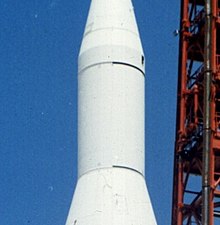Saturn I
The Saturn I[a] was a rocket designed as the United States' first medium lift launch vehicle for up to 20,000-pound (9,100 kg) low Earth orbit payloads.
President John F. Kennedy identified the Saturn I, and the SA-5 launch in particular, as being the point where US lift capability would surpass the Soviets, after being behind since Sputnik.
[3][4] The Saturn project was started as one of a number of proposals to meet a new Department of Defense (DoD) requirement for a heavy-lift vehicle to orbit a new class of communications and "other" satellites.
Wernher von Braun's team at the U.S. Army Ballistic Missile Agency (ABMA) started studying the problem in April 1957.
This approach became the favorite and was paired with a first stage built from a cluster of nine tanks placed atop a thrust plate where the engines and plumbing would be attached.
ARPA asked for only one change to the design; concerned that the E-1 was still in early development, they suggested looking at alternatives in order to ensure the rocket would enter production as soon as possible.
On 23 September 1958, ARPA and the Army Ordnance Missile Command (AOMC) drew up an additional agreement enlarging the scope of the program, stating "In addition to the captive dynamic firing..., it is hereby agreed that this program should now be extended to provide for a propulsion flight test of this booster by approximately September 1960".
von Braun had high hopes for the design, feeling it would make an excellent test-bed for other propulsion systems, notably the F-1 if it matured.
He outlined uses for the Juno V as a general carrier vehicle for research and development of "offensive and defensive space weapons".
Specific uses were forecast for each of the military services, including navigation satellites for the Navy; reconnaissance, communications, and meteorological satellites for the Army and Air Force; support for Air Force crewed missions; and surface-to-surface logistics supply for the Army at distances up to 6400 kilometers.
The formation of NASA on 29 July 1958 led to an effort to collect the existing heavy-launch rocket programs and select a single set of designs for future work.
[7] The SLS used a set of common modular components with solid fuel boosters and hydrogen/oxygen upper stages to allow a wide variety of launch configurations and payload weights.
Both groups had also developed plans for crewed lunar bases, ABMA's Horizon with its Earth Orbit Rendezvous method of building a large lunar rocket in Earth orbit, and the Air Force's Lunex Project which planned on launching a single huge lander using the largest of the SLS configurations.
Vega was later cancelled when information on the formerly secret Agena upper stage was released (then known as "Hustler"), and it had performance roughly comparable to NASA's design.
Then, quite unexpectedly, on 9 June 1959, Herbert York, Director of Department of Defense Research and Engineering, announced that he had decided to terminate the Saturn program.
A three-day meeting between 16 and 18 September 1959 followed, where York and Dryden reviewed Saturn's future and discussed the roles of the Titan C and Nova.
NASA was equally concerned that by relying on third parties for their boosters they were putting their entire program in jeopardy, and were very open to the idea of taking over the team.
By a presidential executive order on 15 March 1960, ABMA became NASA's George C. Marshall Space Flight Center (MSFC).
On this change Medaris noted: In order to reach some sort of accommodation, a group pulled from NASA, Air Force, ARPA, ABMA, and the Office of the Department of Defense Research and Engineering formed under the Silverstein Committee in December.
The C models easily outperformed the A's and B's, with the added advantage that they were interchangeable and could be built up in order to fit any needed payload requirement.
These new designs, the Titan IIIs, became the DoD's main heavy-lift launch vehicle for decades afterward as it cost significantly less to manufacture and fly, in part due to using hypergolic propellants that could be stored at room temperature.
Likewise, the development of the Titan III eliminated the need for the "flexible" staging concepts of the Saturn, which was now only intended to be used for crewed launches in the Apollo program.
Tension in the blockhouse was high as no launch vehicle to date had been successful on the first attempt and there was the widespread fear of a pad explosion.
As the Saturn was the largest booster yet flown, such an event was sure to be extremely destructive, possibly putting the launch complex out of use for six months.
Two of them had the S-IV filled with water and detonated at high altitude after stage separation to form an ice cloud that was then photographed.
Flight #5 in January 1964 was the first to carry a live S-IV, which restarted its engine in orbit to boost to a high altitude where it would remain until decaying two years later.
By this point, however, the advent of the Titan III had robbed the Saturn of a role as a DoD launcher and with the newer, improved Saturn IB in development (as the Apollo CSM ended up being heavier than originally expected and so needed a more powerful launch vehicle), the booster quickly became orphaned and no practical use could be found for it.
The main payload of the Saturn I was the boilerplate version of the Apollo Command and Service Modules and Launch Escape System.
[citation needed] TABAS armed the Saturn with 25 metric tons (55,000 lb) of conventional weapons in a mechanical carrier system that ensured that the missile would hit and destroy an enemy runway, knocking it out of action for three days.
In 2019, it was reported that this stage has been made available by NASA for donation to an organization, with the only provision being an approximately $250,000 "shipping fee" for transportation costs.






